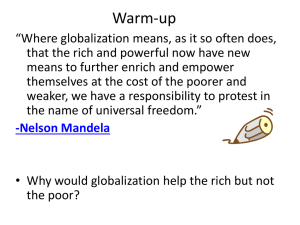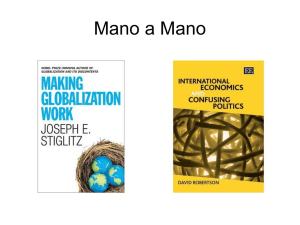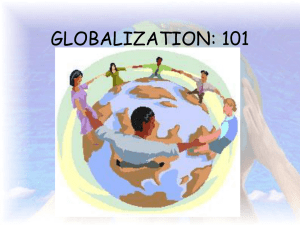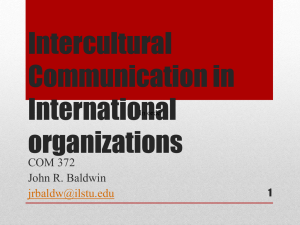GLOBALIZATION_AND_GLOBAL_LEADERSHIP- DR
advertisement
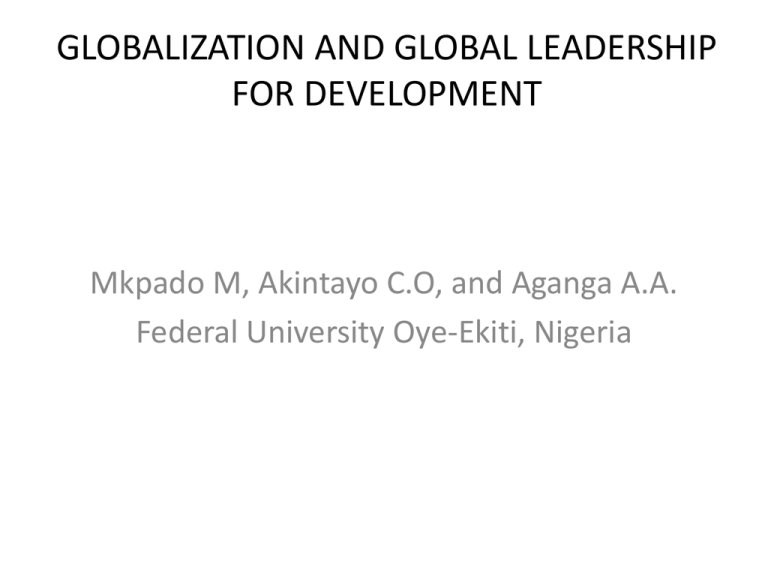
GLOBALIZATION AND GLOBAL LEADERSHIP FOR DEVELOPMENT Mkpado M, Akintayo C.O, and Aganga A.A. Federal University Oye-Ekiti, Nigeria Outline Globalization-history, indicators, meaning, advantages and disadvantages Global leadership-definition, global mind set, global leaders Developing countries and developed countries Intellectual property: A strategy for development Some issues in international development Appropriate technology for regional development Major contributing factors of Korea’s development Korea culture for business practices History of globalization • Yoo (2012) stated that the earliest known term referring to globalization was used by C. T. Russell in 1897 as ‘corporate giants’. • The 19th century brought globalization experiences because of influence and presence of colonial masters. • This first era of globalization was short lived • Why? • the gold standard crisis and the great depression in the late 1920s and early 1930s. What is globalization? • Globalization is the process by which nations/economies around the world become increasingly integrated. • Social/cultural view: globalization can refer to the circulation of ideas, languages, or popular culture among nations; via learning. • Economic globalization refers to a process by which economics, societies, and cultures have become integrated through a global network of communication, transportation, trade and financial relations (Yoo, 2012). Some institution facilitating globalization • United Nations, (international organizationUNESCO, UNICEF, UNECA, UN-IRA etc) • World Bank, • IBRD, • IMF, • WTO-using GATT, regional organizationsECOWAS, AU, etc What are the indicators /measures of globalization? • • • • • • • • • The four main economic flows that characterise globalization are -goods and services -labour/people -capital -technology degree of openness tariff measures multivariate approach A Swiss think tank ("Konjunkturforschungsstelle"-KOF) used a multivariate approach to measure globalization in 2011, • Results? • More globalized : Singapore, Switzerland, the Netherlands, Canada and Denmark • Less globalized: Indonesia, India, and Iran were the least globalized among the countries listed. Some Advantages of globalization • It increases free trade between nations (Steger, Manfred (2002), • increases liquidity of capital allowing investors in developed nations to invest in developing nations -FDI • corporations have greater flexibility to operate across borders (Yoo,2012) • increase in the flow of information across the globe , • Increase in the movement of people among nations/states Some Disadvantages of Globalization • Competition:-large scale firm vs. small scale firms • Increased unemployment in less developed countries • Contamination /destroying of local cultures • International organization like WTO infringing on national and individual sovereignty. What is global leadership? And what are Challenges to global leaders? • What is global Leadership? • It's about managing an integrated enterprise across borders where you encounter different cultural, legal, regulatory and economic systems (Stephen 2012) • Ability to unleash human potential and leverage the richness that lies in cultural diversity (Rosinski, 2003) • Challenges to global leaders • How to influence individuals, groups, and organizations inside and outside their own organization • Coordinating diverse cultural/political/institutional system to help achieve their organization’s global ambitions (Yoo, 2012). ATTITUDE OF GLOBAL LEADERS • A most for global leaders is open your mind to everything; close it to nothing (Yoo, 2012) • Global leaders must have the global mind set • It’s the ability to understand the similarities and differences among cultures and their reasons as well as the ability to effectively sell your own ideas without raising issues. • Global leaders do not accept ethnocentrism What are the features of global mind set? • The ability to influence individuals, organizations, groups, and systems that are unlike the leader’s. • The ability to understand and respect other peoples cultures rather than judging them • The ability to explore the complexity of other cultures without being intimidated • Being comfortable with being uncomfortable in an uncomfortable environment is a must (Yoo, 2012). Global mind set and effective global leadership requires Intellectual capital, psychological capital and social capital GLOBAL LEADERS • G8 • G 20 • G28 Developing countries and developed countries • According to Yoo (2012) Many common features exist between the two! But their magnitude differs eg. • Industries • Urban centres • Rural settlements • Criteria for determining developed and developing countries • GDP-Gross domestic product- poverty level • Less then $1.00, less than $1.25 • Life Expectancy-mortality rate, Developing countries and developed countries • • • • Literacy Rate Highest education level of the majority Healthcare System Level of industrialization-subsistence farming, commercial farms small scale firms, large scale firms, heavy chemical industries. • ATTITUDE- developed countries always do the right thing. Intellectual property : A strategy for development • Intellectual property is the exclusive right given to one who invested something, producing or marketing goods or service to recognize his/her efforts and time to earn benefits from the innovation (Erick, 2012) • Intellectual property flues innovation • Types of intellectually property • Copyright- for text books, novels, drama etc • Patent- engineering innovations-machines, drugs • Trademark- marketing, running a company Intellectual property • Countries without intellectual property laws will likely have low innovation and inventions (Erick, 2012) • Strong intellectual property law is required to safeguard companies establishing factories in a countries • All technological innovation to be generated by FUOYE will need to be registered to get the patent and maximize the accruing benefits • FUOYE can sell the patent to a company if she can not commercialize it. • As done by IBM Some issues in international development • • • • Globalization and its associated competition Models of development: State–led Approach Industrialization as a means of catching up with economic achievement of the North (Pong, 2012) • Structuralist approach- identify underlying structures in the international economy • Morden approach-identify domestic factors as the constraints to development • Integrated approach Some issues in international development • Market–led approach: neo-liberal development policies emphasis the importance of market principles • Trade libralization • Structural adjustment based on market principles (Pong, 2012) • (major limitation is market failures-John Maynard Keynes) Some issues in international development • • • • Post –Washington consensus: Economic growth is not enough Poverty reduction is essential for development National governments of developing countries must own development strategies • Civil society participation is essential • Good governance is very important Some issues in international development • UN Millennium development goals • UN MDGs –the 8 Goals • Many developing countries failed to attain the goals • The post 2015 MDGs Agenda – Rio+20 Appropriate technology for regional development • Less developed countries can start form simple technology (Chang, 2012) eg • Pot-in pot cooler • More efficient stoves • Q-Drum • Life straw for water purification • Fuel from fields • Building capacity for science, technology and innovation (STI) Major contributing factors of Korea’s development • • • • • • • • • • Strong political will visionary leadership Late president Park Infrastructure building strategy (Choi, 2012) Seoul-Busan road Restricted importation and production for export Industrialization- HCI Flexibility in adoption of economic principles Continuity of national development plan Accountability/openness Communal sprit- eg the citizens contributed their gold for payment of their loan from IMF 3 years before due date; clearing oil pollution in sea (Choi, 2012). • Development of human capital Korea culture for business practices • • • • • • • • • • • • Language-Korea some speak English Respect Body language (Yoo, 2012) Punctuality Vertical social structure Personal ties eg kingship Business cards Gift giving Signing of contracts Modesty and humility Don’t use no 4 and red colour use the person’s title and surname APPRECIATION APPRECIATION • The vice chancellor- FUOYE


